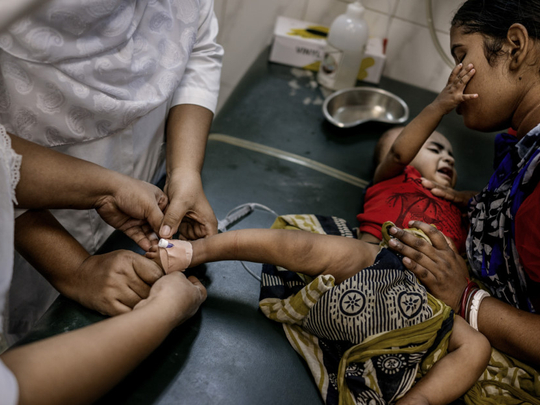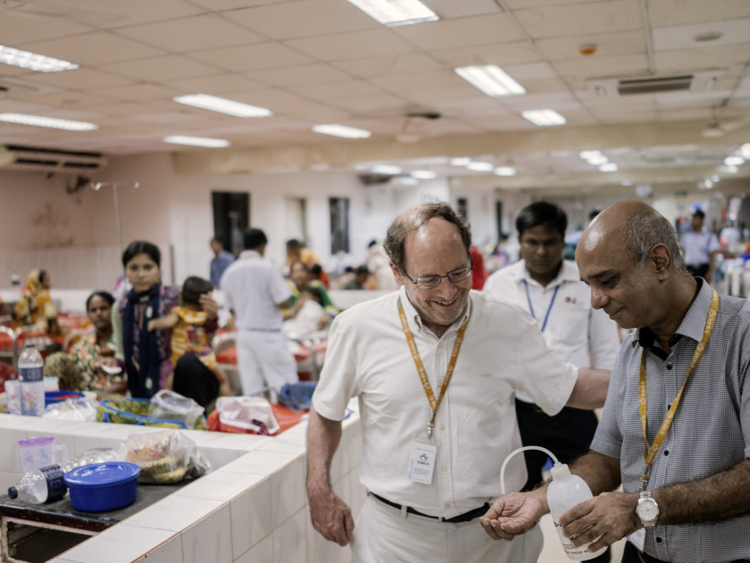
Two hundred years ago, the first cholera pandemic emerged from these tiger-infested mangrove swamps. It began in 1817, after the British East India Co sent thousands of workers deep into the remote Sundarbans, part of the Ganges River Delta, to log the jungles and plant rice. These brackish waters are the cradle of Vibrio choleras, a bacterium that clings to human intestines and emits a toxin so virulent that the body will pour all of its fluids into the gut to flush it out.
Water loss turns victims ashen; their eyes sink into their sockets, and their blood turns black and congeals in their capillaries. Robbed of electrolytes, their hearts lose their beat. Victims die of shock and organ failure, sometimes in as little as six hours after the first abdominal rumblings.
Cholera probably had festered here for aeons. Since that first escape, it has circled the world in seven pandemic cycles that have killed tens of millions.
Artists of the 19th century often depicted it as a skeleton with a scythe and victims heaped at its feet. It stalked revellers at a masked ball in Heinrich Heine’s “Cholera in Paris” and kills the protagonist in Thomas Mann’s “Death in Venice.” Outbreaks forced London, New York and other cities to create vast public water systems, transforming civic life.
Today cholera garners panicky headlines when it strikes unexpectedly in places such as Ethiopia or Haiti. But it is a continuing threat in nearly 70 countries, where more than one billion people are at risk.
Now, thanks largely to efforts that began in cholera’s birthplace, a way to conquer the long-dreaded plague is in sight.
A treatment protocol so effective that it saves 99.9 per cent of all victims was pioneered here. The World Health Organisation estimates that it has saved about 50 million lives in the past four decades.
Just as important, after 35 years of work, researchers in Bangladesh and elsewhere have developed an effective cholera vaccine. It has been accepted by the WHO and stockpiled for epidemics like the one that struck Haiti in 2010. Soon, there may be enough to begin routine vaccination in countries where the disease has a permanent foothold.
Merely creating that stockpile — even of a few million doses — profoundly improved the way the world fought cholera, Dr Margaret Chan, secretary-general of the WHO, said last year. Ready access to the vaccine has made countries less tempted to cover up outbreaks to protect tourism, she said.
That has sped up emergency responses and attracted more vaccine makers, lowering costs. “More cholera vaccines have been deployed over the last two years than in the previous 15 years combined,” Chan said.
A revolution in recovery
The treatment advances relied heavily on research and testing done at the International Center for Diarrheal Disease Research, known as the ICDDR, B, in Dhaka.
Although Dhaka may not be the first place one might look to find a public health revolution, the centre is famous among experts in gut diseases.
While its upper levels are quiet and scholarly, the centre’s ground floor is the world’s largest diarrhoea hospital. Its vast wards treat 220,000 patients a year, almost all of whom recover within 36 hours. Doctors there save hundreds of lives a day.
The ICDDR, B was originally the Cholera Research Laboratory, founded in 1960 by the United States as part of that era’s “soft diplomacy”. Research hospitals were built in friendly countries both to save lives locally and to act as sentinels for diseases that might threaten America.
The wards, which in the rainy season extend into circus-size tents in the parking lot, contain long rows of “cholera cots”. On each iron or wood frame is a plastic sheet with a hole in the middle. A bucket beneath the hole catches diarrhoea, while another beside the cot fills with vomit. An IV pole completes the set-up.
Defying expectations, the ward smells only of the antiseptic that the floors are constantly mopped with.
Patients with severe watery diarrhoea arrive around the clock, many of them carried in — limp, dehydrated and barely conscious — by friends or family. A nurse sees each one immediately, and those close to death get an IV line inserted within 30 seconds.
It contains a blend of glucose, electrolytes and water. Cholera spurs the intestines to violently flush themselves, but it does not actually damage the gut cells. If the fluid is replaced and the bacteria flushed out or killed by antibiotics, the patient is usually fine.
Within hours, patients start to revive. As soon as they can swallow, they get an antibiotic and start drinking a rehydration solution. Most walk out within a day. The techniques perfected here are so effective that the ICDDR, B has sent training teams to 17 cholera outbreaks in the past decade.
Usually, the only patients who stay long in the hospital are infants so malnourished that another bout of diarrhoea would kill them. They live for up to a month in a separate ward with their mothers, who are taught how to cook nutritious porridges from the cheapest lentils, squash, onions, greens and oil.
Only about 20 per cent of the patients at the centre have cholera. The rest usually have rotavirus, salmonella or E. coli. The same therapy saves them all, but the cholera cases are more urgent because these patients plummet so precipitously towards death.
Cholera, born in the swamps, arrived long ago in Dhaka. The city is home to more that 15 million, and a third of the population lives in slums. In some places, water pipes made of rubbery plastic are pierced by illegal connections that suck in sewage from the gutters they traverse and carry pathogens down the line to new victims.
Vibrio choleras travels from person to person via faecal matter. In 1854, epidemiologist John Snow famously traced cases to a single well dug near a cesspit in which a mother had washed the diaper of a baby who died of cholera and he convinced officials to remove the well’s pump handle.
Because cholera is a constant threat to hundreds of millions of people lacking safe drinking water in China, India, Nigeria and many other countries, scientists have long sought a more powerful weapon: a cheap, effective vaccine. Now they have one.
Preventing a plague
Injected cholera vaccines were first invented in the 1800s and were long required for entry into some countries. But many scientists suspected they did not work, and in the 1970s studies overseen by the ICDDR, B confirmed that.
In the 1980s, a Swedish scientist, Dr Jan Holmgren, invented an oral vaccine that worked 85 per cent of the time. But it was expensive to make and had to be drunk with a large glass of buffer solution to protect it from stomach acid.
Transporting tanks of buffer was impractical. Making matters worse, it was fizzy, and poor Bangladeshi children who had never tasted soft drinks would spit it out as soon as it tickled their noses.
In 1986, a Vietnamese scientist, Dr Dang Duc Trach, asked for the formula, believing he could make a bufferless version. Holmgren and Dr John D. Clemens, an American vaccine expert who at the time was a research scientist for the ICDDR, B, obliged.
“This isn’t an elegant vaccine — it’s just a bunch of killed cells, technology that’s been around since Louis Pasteur,” said Clemens, who is now the ICDDR, B’s executive director.
He and Holmgren lost touch with Dang, largely because of Vietnam’s isolation in those days. But seven years later, Dang notified them that he had made a new version of the vaccine. He had tested it on 70,000 residents of Hue, in central Vietnam, and had found it to be 60 per cent effective.
Although his was not as effective as Holmgren’s, it cost only 25 cents a dose. If enough people in an area can be made immune through vaccination, outbreaks often stop spontaneously.
In 1997, Vietnam became the first — and thus far, only — country to provide cholera vaccine to its citizens routinely, not just in emergencies. Cases dropped sharply, according to a 2014 study, and in 2003 cholera vanished from Hue, where the campaign focused most heavily.
But Dang had not conducted a classic clinical trial, and Vietnam’s vaccine factory did not meet WHO standards, so no UN agency was allowed to buy his vaccine.
Because no pharmaceutical company had an incentive to pay for trials or factories, his invention languished in “the valley of death” — the expensive gap between a product that works in a lab and a factory-made version safe for millions.
In 1999, Clemens approached what is now the Bill & Melinda Gates Foundation, which was just getting organised.
“They were literally operating out of a basement then,” he said. “I got a letter from Bill Gates senior It was very relaxed, sort of, ‘Here’s $40 million. Would you mind sending me a report once in a while?’
“But without that,” Clemens continued, “this wouldn’t have seen the light of day.”
With that money, Clemens reformulated Dang’s vaccine, conducted a successful clinical trial in Kolkata and found an Indian company, Shantha Biotechnics, that could make it to WHO standards.
Rolled out in 2009 under the name Shanchol, it came in a vial about the size of a chess rook, needed no buffer and cost less than $2 a dose. Even so, there was little interest, even from the WHO.
The vaccine lacked the publicity campaign that pharmaceutical companies throw behind commercial products, and “cholera ward care” was saving many lives — when it could be organised. The new vaccine was not used in a cholera outbreak in Zimbabwe in 2009, or initially in Haiti’s explosive outbreak in 2010.
The “valley of death” lengthened: Without customers, Shantha could not afford to build a bigger factory. The impasse was broken only when Dr Paul Farmer, a founder of Partners in Health, which has worked in central Haiti since 1987, began publicly berating the WHO for not moving faster.
The WHO approved Shanchol in 2011, and since then, the vaccine has slowly gained acceptance. In 2013, an emergency stockpile was started, and the GAVI Alliance committed $115 million to raise it to 6 million doses.
Looking back on his long struggle to prove the vaccine’s value, and then to win acceptance, Clemens offered an explanation that blended wistfulness and cynicism. “We’re probably not bad scientists,” he said, “but we were lousy advocates.
“If this disease had been in American kids, there would have been trials as fast as the Sabin polio vaccine.”
— New York Times News Service














